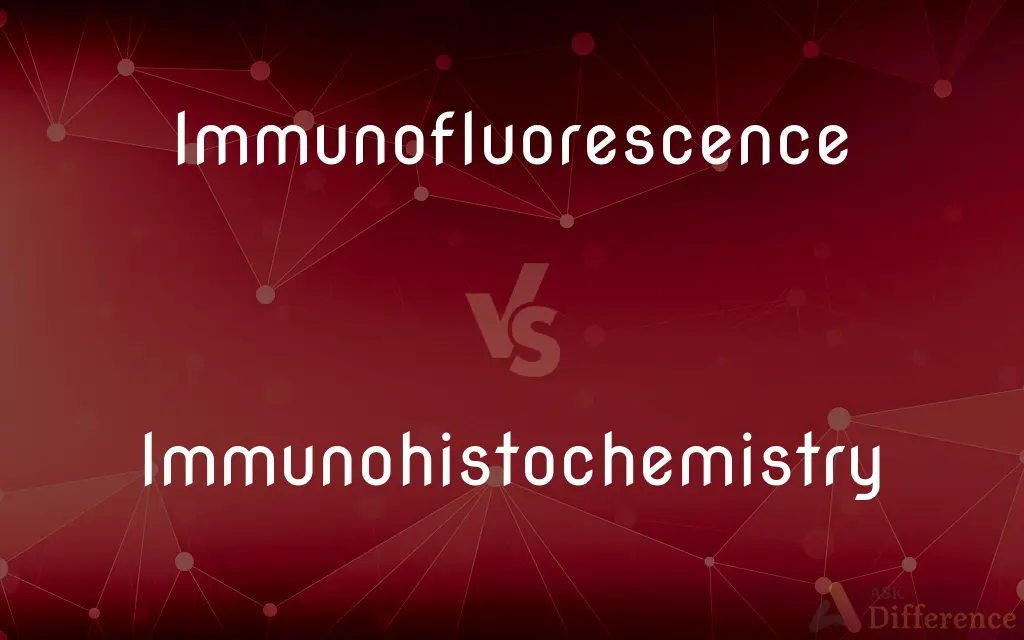Immunofluorescence vs. Immunohistochemistry — What's the Difference?
Edited by Tayyaba Rehman — By Maham Liaqat — Updated on April 25, 2024
Immunofluorescence uses fluorescent dyes to visualize antigens, ideal for detecting multiple targets simultaneously, while immunohistochemistry employs enzymes and chromogens for detailed tissue structure analysis.

Difference Between Immunofluorescence and Immunohistochemistry
Table of Contents
ADVERTISEMENT
Key Differences
Immunofluorescence utilizes fluorescently labeled antibodies to detect specific antigens within cells or tissues, providing bright, visually striking images. On the other hand, immunohistochemistry (IHC) relies on enzyme-linked antibodies that produce a colorimetric reaction, making it easier to observe antigen presence within the context of tissue morphology.
Immunofluorescence can be applied in both direct and indirect methods, where direct involves a labeled antibody binding directly to the target antigen, and indirect uses a secondary antibody to amplify the signal. Whereas, immunohistochemistry primarily uses the indirect method, enhancing sensitivity through the amplification of the primary antibody's signal via a secondary antibody linked to an enzyme.
The technique of immunofluorescence allows for the simultaneous visualization of multiple antigens by using antibodies tagged with different fluorescent dyes. This multiplexing capability is a distinct advantage in complex biological systems. On the other hand, IHC typically visualizes one antigen at a time, although recent advancements have enabled multiplexing to a limited extent.
Immunofluorescence is highly sensitive and suitable for detailed cellular and subcellular studies, often used in research settings. In contrast, immunohistochemistry is robust and widely used in clinical diagnostics due to its ability to provide detailed morphological context, which is crucial for disease diagnosis.
While immunofluorescence is best observed under a fluorescence microscope or confocal microscope, requiring specific equipment and expertise, immunohistochemistry can be performed and analyzed using standard light microscopy, making it more accessible for routine clinical laboratories.
ADVERTISEMENT
Comparison Chart
Labeling Technique
Fluorescent dyes
Enzymes and chromogens
Visualization Equipment
Fluorescence microscope, confocal
Standard light microscope
Multiplexing Capability
High (multiple antigens simultaneously)
Limited
Primary Use
Research, detailed cellular studies
Clinical diagnostics, tissue analysis
Method Sensitivity
High sensitivity for detecting antigens
High with detailed morphological context
Compare with Definitions
Immunofluorescence
Simultaneous detection of multiple antigens using different fluorescent dyes.
Multiplex immunofluorescence facilitates the study of interactions within cellular pathways.
Immunohistochemistry
Uses an enzyme-linked secondary antibody to visualize the primary antibody binding.
Enzyme-linked antibodies in IHC cause a chromogenic reaction visible under light microscopy.
Immunofluorescence
Detects antigens using a fluorescently labeled antibody directly binding to the target.
Direct immunofluorescence is used to identify specific proteins in tissue sections.
Immunohistochemistry
The standard tool for viewing IHC-stained samples.
Light microscopy allows pathologists to assess IHC slides for diagnostic purposes.
Immunofluorescence
Provides enhanced imaging resolution and depth by scanning samples with a laser.
Confocal microscopy is used in immunofluorescence to obtain high-resolution images of cellular structures.
Immunohistochemistry
Chemicals that react with enzyme-linked antibodies to produce colored deposits.
DAB is a chromogen substrate commonly used in IHC to yield a brown coloration at the antigen site.
Immunofluorescence
A technique to visualize fluorescent labels in biological samples.
Fluorescent microscopy is essential for analyzing immunofluorescence results.
Immunohistochemistry
Technique in IHC to enhance the visibility of the antibody-antigen interaction.
Signal amplification in IHC is achieved through biotin-streptavidin systems enhancing diagnostic accuracy.
Immunofluorescence
Employs a secondary antibody to bind to the primary antibody, increasing signal intensity.
Indirect immunofluorescence enhances signal detection in cellular imaging.
Immunohistochemistry
IHC is extensively used to diagnose diseases by identifying specific antigens in tissues.
IHC is crucial for diagnosing various types of cancer.
Immunofluorescence
Immunofluorescence is a technique used for light microscopy with a fluorescence microscope and is used primarily on microbiological samples. This technique uses the specificity of antibodies to their antigen to target fluorescent dyes to specific biomolecule targets within a cell, and therefore allows visualization of the distribution of the target molecule through the sample.
Immunohistochemistry
Immunohistochemistry (IHC) is the most common application of immunostaining. It involves the process of selectively identifying antigens (proteins) in cells of a tissue section by exploiting the principle of antibodies binding specifically to antigens in biological tissues.
Immunofluorescence
Any of various techniques that use antibodies chemically linked to a fluorescent dye to identify or quantify antigens in a tissue sample.
Immunohistochemistry
The analytical process of finding proteins in cells of a tissue microtome section exploiting the principle of antibodies binding specifically to antigens in biological tissues.
Immunofluorescence
A technique that uses a fluorochrome to indicate a specific antigen-antibody reaction
Immunohistochemistry
An assay that shows specific antigens in tissues by the use of markers that are either fluorescent dyes or enzymes (such as horseradish peroxidase)
Immunofluorescence
(immunology) a technique that uses antibodies linked to a fluorescent dye in order to study antigens in a sample of tissue
Common Curiosities
Is immunohistochemistry suitable for research purposes?
Yes, IHC is extensively used in research, particularly in studies requiring detailed tissue and cellular analysis.
What makes multiplex immunofluorescence advantageous in research?
It allows for the simultaneous visualization of multiple targets, providing comprehensive insights into cellular functions and interactions.
What are the typical applications of immunofluorescence?
It's mainly used in molecular biology and medical research to study cell structures and functions.
Can immunofluorescence be used in clinical diagnostics?
Yes, although less common than IHC, immunofluorescence is used in specific clinical applications, like autoimmune disease diagnosis.
How does the sensitivity of immunofluorescence compare to immunohistochemistry?
Immunofluorescence is generally more sensitive due to the high specificity and brightness of fluorescent dyes, but IHC provides more contextual detail.
How do direct and indirect immunofluorescence differ?
Direct uses a labeled primary antibody, simpler but less sensitive; indirect involves an unlabeled primary and a labeled secondary antibody, enhancing sensitivity.
How do enzyme-linked antibodies work in IHC?
They bind to the primary antibody and react with a substrate to produce a visible color at the antigen site.
What is the main difference between immunofluorescence and immunohistochemistry?
Immunofluorescence uses fluorescent dyes for antigen detection, ideal for multiple targets; immunohistochemistry uses enzymes and chromogens, emphasizing tissue structure.
Can immunohistochemistry detect multiple antigens simultaneously?
While traditionally limited to one antigen, recent techniques allow for limited multiplexing in IHC.
Why is immunohistochemistry preferred in clinical settings?
Its robustness and the detailed morphological context it provides make it ideal for routine diagnostics.
What type of microscope is needed for immunofluorescence?
A fluorescence or confocal microscope is necessary for observing the fluorescent signals in immunofluorescence.
What is the role of confocal microscopy in immunofluorescence?
It enhances image resolution and depth, crucial for detailed cellular analysis.
What are common chromogens used in IHC?
Diaminobenzidine (DAB) and Hematoxylin are common, producing visible stains at antigen sites.
Is there a significant cost difference between these techniques?
Yes, immunofluorescence can be more costly due to the reagents and specialized equipment required.
Which method is faster for obtaining results?
IHC generally provides quicker results, particularly important in clinical diagnostic settings.
Share Your Discovery

Previous Comparison
Minecraft vs. Roblox
Next Comparison
Brainly vs. CheggAuthor Spotlight
Written by
Maham LiaqatEdited by
Tayyaba RehmanTayyaba Rehman is a distinguished writer, currently serving as a primary contributor to askdifference.com. As a researcher in semantics and etymology, Tayyaba's passion for the complexity of languages and their distinctions has found a perfect home on the platform. Tayyaba delves into the intricacies of language, distinguishing between commonly confused words and phrases, thereby providing clarity for readers worldwide.
















































